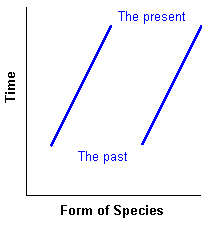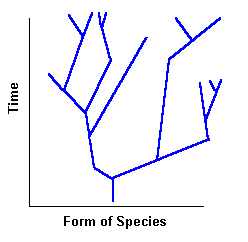Clones are "identical". The quotes are to remind me
that "identical" is not completely true. After being
born clones may become less identical due to the environment.
Some species can reproduce by cloning themselves and all the offspring
are "identical" to the parent. This is common in plants
(where it is often called "vegetative propagation")
and among some invertebrates. Dolly the sheep is a clone, but
she is unusual and not a good example of natural evolution.
Humans don't reproduce by cloning (yet) but on occasion two humans
are born that have inherited the exact same characteristics. These
are known as "identical twins" because they share identical
inherited characteristics. Although we call them "identical
twins" the environment starts to shape them and they soon
take on individual characteristics. They are "clones"
of each other but variation starts as the clones grow and interact with
their environment.
You might think that these exceptions would be difficult to accept
in Darwin's theory but they are not. Even these rare exceptions
have their place in Darwinian Evolution but this is getting off
the point and we should not get too far ahead of ourselves.
Indeed, this would be a good time to review the essence of Darwin's
Theory of Natural Selection.
Let's list the facts and derive some important Darwinian inferences.
FACT 1: All species have massive potential fecundity. (Fecundity
is the ability to reproduce.)
FACT 2: Populations are stable - they are not continually growing.
FACT 3: Natural resources are limited, therefore populations cannot
maintain exponential growth for long.
From these facts we can derive an important inference.
INFERENCE 1: Only a fraction of the individuals produced each
generation can survive, so there must be a "struggle for
existence".
FACT 4: Individuals of a population vary extensively in their
characteristics - no two individuals are alike. (Clones and identical
twins are rare exceptions and even these are not truly identical
due to the environment.)
FACT 5: Much of this variation is heritable. It can be passed
on from parents to offspring.
INFERENCE 2: Survival in the struggle for existence is not random,
but depends in part on the hereditary characteristics of each
individual. Those individuals that happen to have characteristics
better suited to their environment will survive and leave more
offspring - they have greater "fitness".
"Fitness" is a term you often hear in Biology. It refers
to how well adapted an individual is to its environment. Recall
that it is the origin of adaptation that any theory of evolution
must understand and explain. Fitness is measured in many
ways depending upon what you are studying, but it is generally
accepted as a quality that allows an individual to function in
its environment.
From the two inferences above we can derive a final, important
inference.
INFERENCE 3: This unequal ability of individuals to survive and
reproduce, due to variations in their fitness, will lead to a
gradual change in a population as more "fit"
individuals survive to reproduce.
Now you know the three major explanations for adaptation (Natural Theology, Inheritance of Acquired Characteristcis and Natural Selection).
You might be wondering why Darwin's theory is the "winner".
Part of the reason has to do with whether a theory, or the hypotheses
that support it, can be "falsified". You will recall that
Natural Theology is a difficult argument to disprove but you may
be wondering if that is a good enough reason to reject it. Perhaps
you're still not satisfied that Lamarck has been given a fair
chance. Of course, the great arbitrator of science is evidence
and one of the greatest bits of scientific evidence with respect
to evolution and adaptation is the fossil record.
Fossils are distributed throughout much of the Earth's geological
record. They are found in "sediments" and usually
arranged in a time sequence with the most recent fossils above
the older ones. (I say "usually" because sometimes the sediments fold over on each other and turn the sequence upside down.) Many fossils are so well preserved that we can
assign names (species) to them and identify specific forms.
Each of the three hypothesis/theories presented in this course
should present a different fossil record. All you have to do is
think about what the fossil record should look like if each hypothesis
is true.
Consider the theory of Inheritance of Acquired Characteristics.
If it is true then the fossil record should show one species (one
form) evolving into another in a direct route. In the case of
giraffe evolution you should find in the fossil record a shortnecked
species that, over time (through the fossil record), changed in
form in a consistent manner. Its neck would get longer with each
generation and there would be a series of "pregiraffes"
with ever increasing lengths to their necks (and legs).
|
Here's what that would look like. I've shown two evolving "forms".
Time is plotted on the Y-axis (vertical).
Form (whatever that may be) is plotted on the X-axis (horizontal).
Form could be anything. In our example it could be the length
of the animals' neck.
These lines show a "form" that is slowly changing over
time.
It changes in a consistent manner. Notice that each "form"
(species) goes from one type to the present type as if they were
two points joined by a single line.
Next to the giraffe is another animal that evolved a long neck.
(Say, a gerenuk.) It too would make a straight line as it passed
on its acquired characteristic (long neck) to its offspring.
| 
|
This is not at all what we see in the fossil record. Indeed, the
fossil record shows one form diverging into several forms.
|
Here is a graph of the fossil record as recorded throughout the world.
Some of those forms have been successful and are still with us.
They made it to the top of the graph which represents the present.
Other forms have gone extinct. Their line ends before the present.
This is the pattern one expects for evolution by Darwin's theory.
We see modification (changes) with descent but that evolution
is not directed towards a specific "goal" in the sense
that it has no continuos track.
| 
|
Draw a graph of what the fossil record would look like if Paley's
theory of natural theology were correct.
(Hint: If species were created by a designer, would there be any
need for "bad designs"?)
Once you've drawn your "evolution graph" continue on
to the next page.
This work was created by Dr Jamie Love  and
and  licensed under a Creative Commons Attribution-ShareAlike 4.0 International License.
licensed under a Creative Commons Attribution-ShareAlike 4.0 International License.
If you like, you can return to the Home Page.


 and
and  licensed under a Creative Commons Attribution-ShareAlike 4.0 International License.
licensed under a Creative Commons Attribution-ShareAlike 4.0 International License.